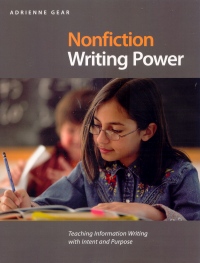| ________________
CM . . .
. Volume XX Number 37. . . .May 23, 2014
excerpt:
When offered the chance to review Nonfiction Writing Power by Adrienne Gear, I was excited. Her books Reading Power and Writing Power are thorough, well-written, and are practical guides for teachers. I had the opportunity to read and review Nonfiction Reading Power for CM and thought it was an excellent resource for classroom teachers that filled a needed niche to help teachers integrate nonfiction texts into their literacy programs. I was eager to see where Gear would take teachers in her fourth “power” book, Nonfiction Writing Power, and how the book connects to her previous books. In the Introduction, Gear connects the four books, explaining how all of the literacy “power” books are ultimately about getting readers and writers to think. She states:
Gear then goes to explain that there are six distinct forms of nonfiction and these are the six nonfiction writing “powers”: descriptive writing, instructional writing, persuasive writing, comparison writing, explanation writing, and nonfiction narrative writing. She also explains how the commonly taught comprehension strategies (making connections, inferencing, questioning, etc.) are integrated into each power. In Chapter One, Gear emphasizes that not all six powers should be taught every year and that schools should take a collaborative approach by mapping out how and when the powers could be taught across the different grades. She also suggests integrating the powers into different subject areas to make the learning more meaningful as well as making the teaching manageable. Blackline masters are provided to help teaching teams plan out subject integration and which grades will teach the powers. Gear suggests that teachers choose two or three nonfiction forms to focus on per grade and that four to six weeks are needed to teach each power. Chapter 2 explains the general setup of the book, such as how teaching the powers uses Donald Grave’s writing process (plan, draft, revise/edit, conference/share) and the gradual release of responsibility model. Gear has designed the book around modeled writing, shared writing, independent writing, and one-on-one conferences. She also emphasizes the importance of using anchor books in teaching writing: “Picture books are woven though the fabric of almost every lesson I teach. Using picture books as the anchor to my writing lessons helps me to introduce a specific writing technique, text structure, or subject.” Chapter Three is entitled “The Big Picture” and consists of lessons to teach students about the idea of nonfiction and the different forms of nonfiction. Chapters 4-9 are each devoted to one of the powers/writing forms. Each chapter contains: the purpose of the form, features and examples of the form, detailed lessons to teach the form, a list of anchor books for a variety of grade levels that are useful in teaching the form, links to content areas, examples of student work, assessments and Blackline masters. Each chapter is very thorough and detailed, yet any teacher can easily adapt the lessons presented to meet the specific needs of his/her classroom. There are a number of elements about Nonfiction Writing Power that I really appreciate on top of the excellent lesson ideas. First, Gear has a broad focus for this book, and it is useful for Kindergarten to Grade 8. Lessons could be used for any grade, and she includes anchor books for different grade levels. Balanced literacy is also very well integrated into the book. Gear’s lessons include modeled, shared, and independent writing so teachers could use this text with their preexisting balanced literacy structure. While guided writing is not specifically included in the book, teachers could easily add this element into their teaching of the nonfiction forms. In addition, Gear makes specific connections to the reading comprehension strategies with which most teachers and students are already familiar (questioning, visualizing, determining importance, etc.) so the book integrates well into the background knowledge of students. Finally, I appreciate how Gear also integrates the six traits of writing into the book (voice, word choice, sentence fluency, organization, ideas, and conventions). Many of the lessons include elements on these commonly taught writing traits. It is difficult to read Nonfiction Writing Power and not be inspired. The book, filled with great ideas to teach nonfiction writing to students, is presented in a clear and manageable format. It is a book I would recommend to any teacher, novice or veteran. Highly Recommended. Dr. Kristen Ferguson teaches literacy education at the Schulich School of Education at Nipissing University in North Bay, ON.
To comment
on this title or this review, send mail to cm@umanitoba.ca.
Copyright © the Manitoba Library Association. Reproduction for personal
use is permitted only if this copyright notice is maintained. Any
other reproduction is prohibited without permission.
NEXT REVIEW |
TABLE OF CONTENTS FOR THIS ISSUE
- May 23, 2014.
AUTHORS |
TITLES |
MEDIA REVIEWS |
PROFILES |
BACK ISSUES |
SEARCH |
CMARCHIVE |
HOME |
